Strategy Development Proposal for Tesco
VerifiedAdded on 2023/01/06
|14
|4531
|63
AI Summary
This report discusses the strategy development proposal for Tesco, a leading retailer in the UK. It provides an overview of the company and its current market status. The report applies Porter's Five Forces Model to analyze the competitive environment. It also proposes a strategy and provides justifications for its choice.
Contribute Materials
Your contribution can guide someone’s learning journey. Share your
documents today.
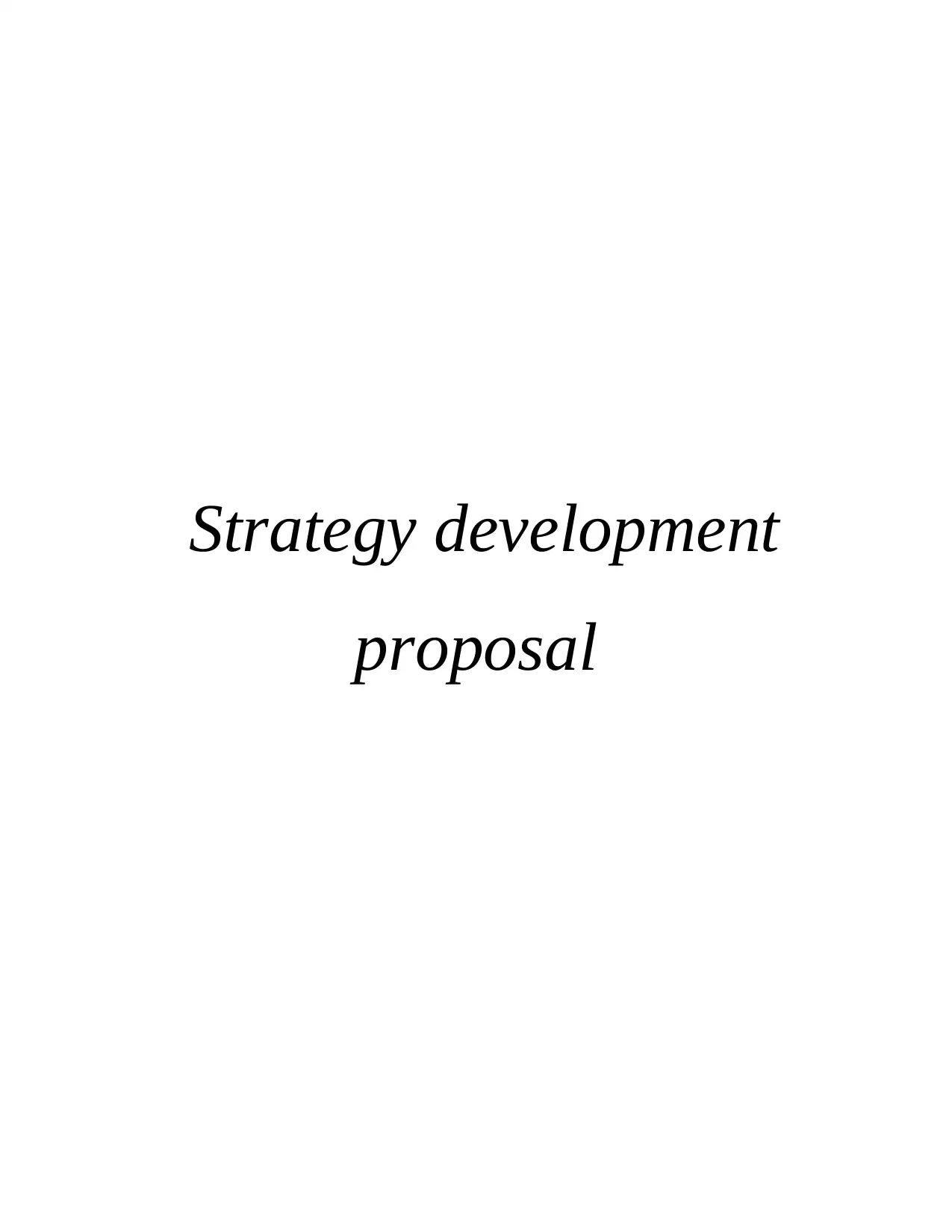
Strategy development
proposal
proposal
Secure Best Marks with AI Grader
Need help grading? Try our AI Grader for instant feedback on your assignments.
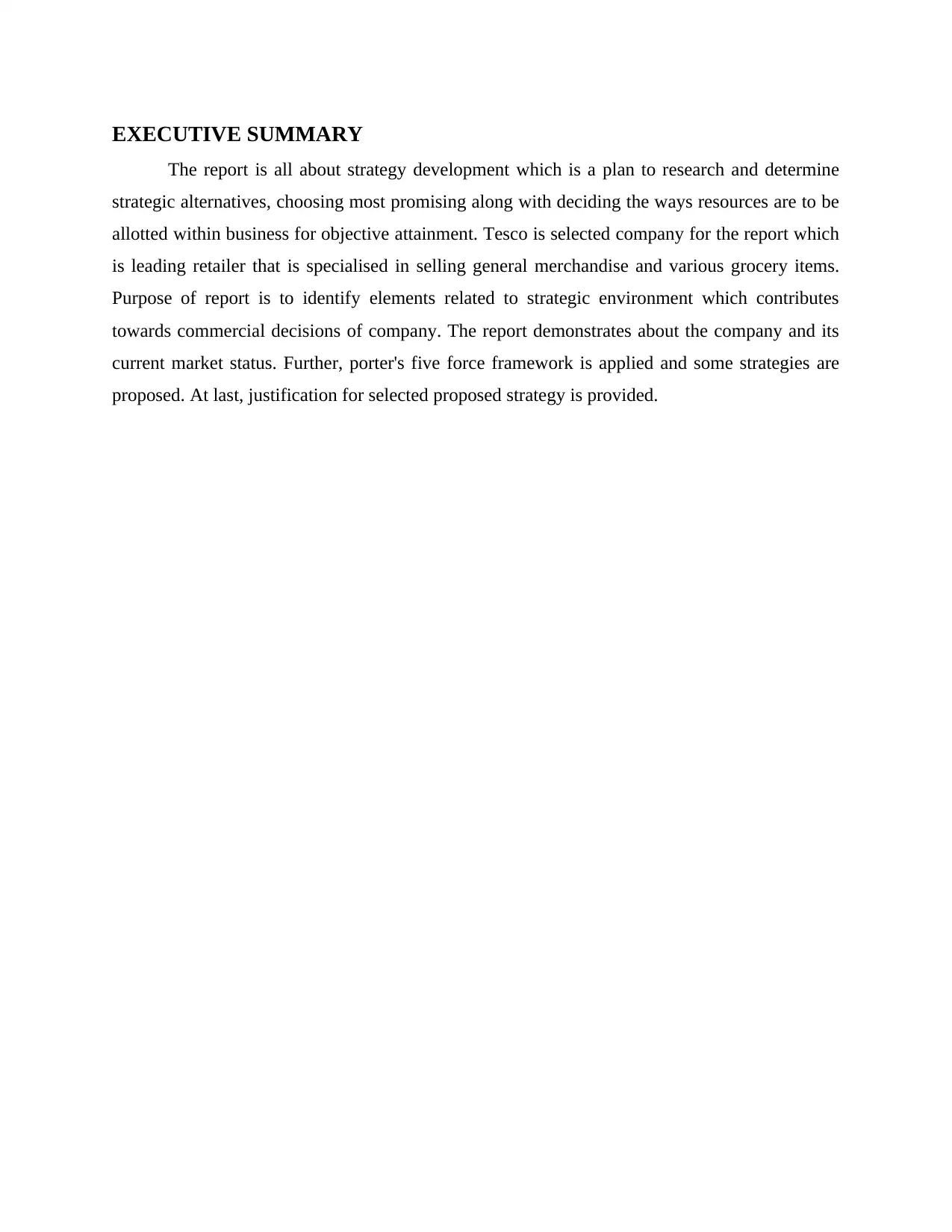
EXECUTIVE SUMMARY
The report is all about strategy development which is a plan to research and determine
strategic alternatives, choosing most promising along with deciding the ways resources are to be
allotted within business for objective attainment. Tesco is selected company for the report which
is leading retailer that is specialised in selling general merchandise and various grocery items.
Purpose of report is to identify elements related to strategic environment which contributes
towards commercial decisions of company. The report demonstrates about the company and its
current market status. Further, porter's five force framework is applied and some strategies are
proposed. At last, justification for selected proposed strategy is provided.
The report is all about strategy development which is a plan to research and determine
strategic alternatives, choosing most promising along with deciding the ways resources are to be
allotted within business for objective attainment. Tesco is selected company for the report which
is leading retailer that is specialised in selling general merchandise and various grocery items.
Purpose of report is to identify elements related to strategic environment which contributes
towards commercial decisions of company. The report demonstrates about the company and its
current market status. Further, porter's five force framework is applied and some strategies are
proposed. At last, justification for selected proposed strategy is provided.
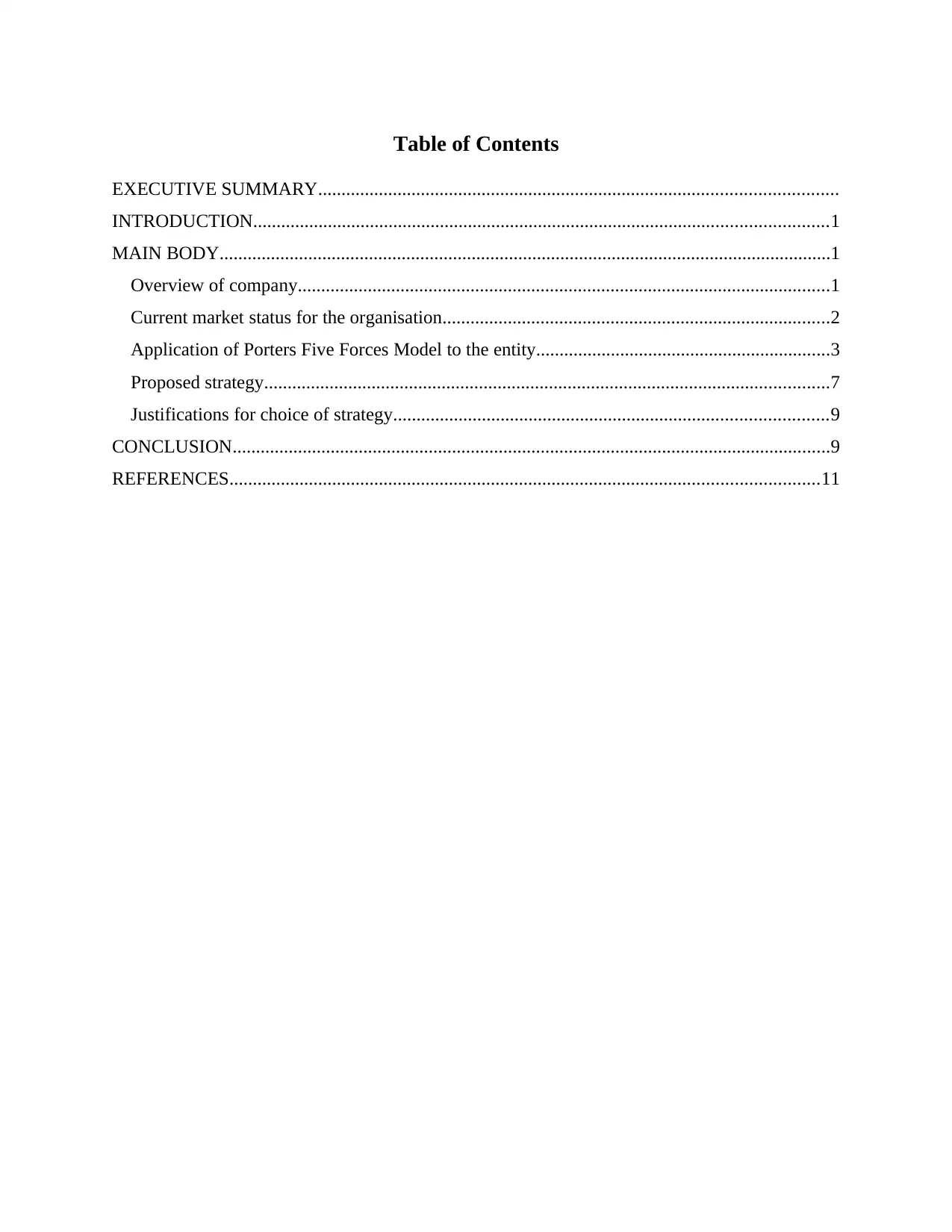
Table of Contents
EXECUTIVE SUMMARY...............................................................................................................
INTRODUCTION...........................................................................................................................1
MAIN BODY...................................................................................................................................1
Overview of company..................................................................................................................1
Current market status for the organisation...................................................................................2
Application of Porters Five Forces Model to the entity...............................................................3
Proposed strategy.........................................................................................................................7
Justifications for choice of strategy.............................................................................................9
CONCLUSION................................................................................................................................9
REFERENCES..............................................................................................................................11
EXECUTIVE SUMMARY...............................................................................................................
INTRODUCTION...........................................................................................................................1
MAIN BODY...................................................................................................................................1
Overview of company..................................................................................................................1
Current market status for the organisation...................................................................................2
Application of Porters Five Forces Model to the entity...............................................................3
Proposed strategy.........................................................................................................................7
Justifications for choice of strategy.............................................................................................9
CONCLUSION................................................................................................................................9
REFERENCES..............................................................................................................................11
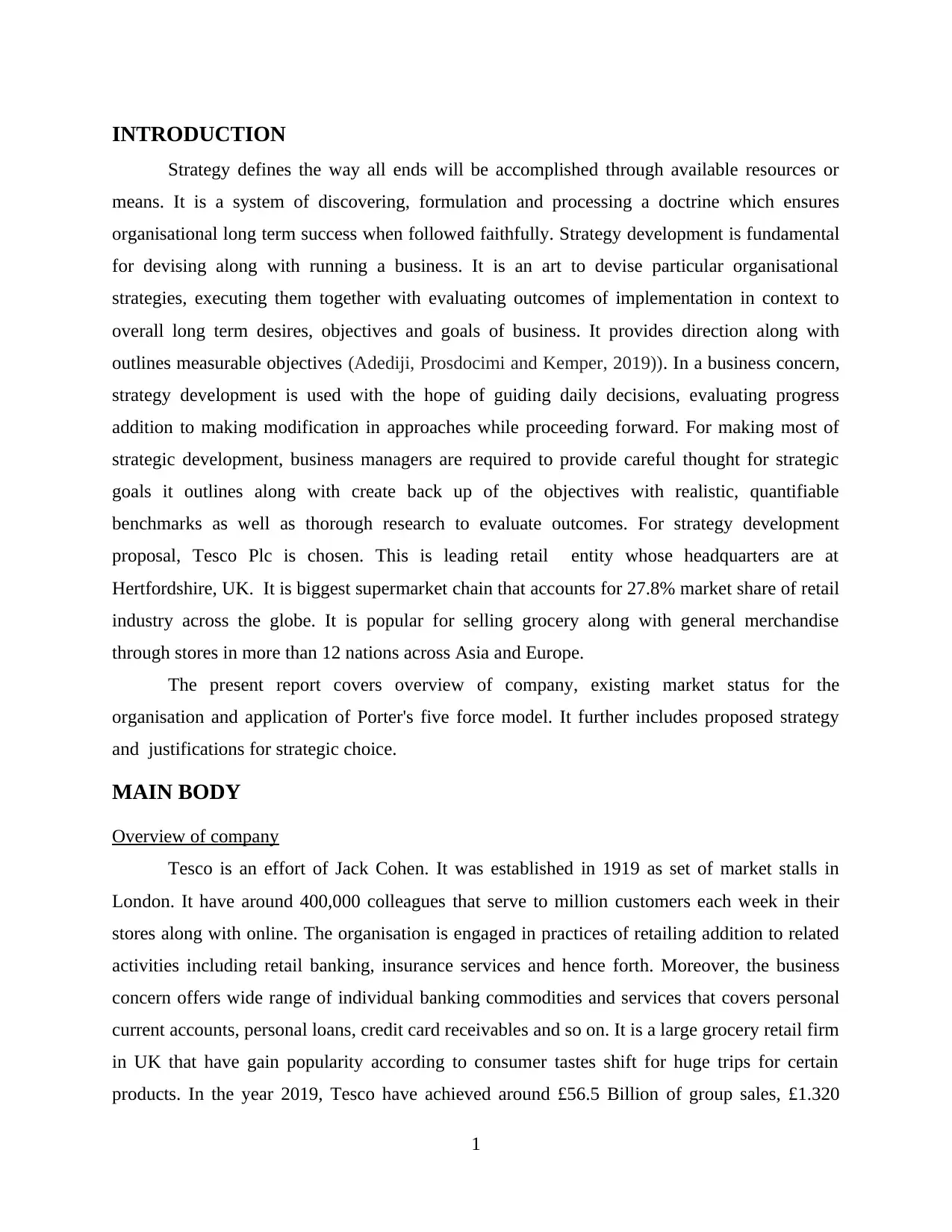
INTRODUCTION
Strategy defines the way all ends will be accomplished through available resources or
means. It is a system of discovering, formulation and processing a doctrine which ensures
organisational long term success when followed faithfully. Strategy development is fundamental
for devising along with running a business. It is an art to devise particular organisational
strategies, executing them together with evaluating outcomes of implementation in context to
overall long term desires, objectives and goals of business. It provides direction along with
outlines measurable objectives (Adediji, Prosdocimi and Kemper, 2019)). In a business concern,
strategy development is used with the hope of guiding daily decisions, evaluating progress
addition to making modification in approaches while proceeding forward. For making most of
strategic development, business managers are required to provide careful thought for strategic
goals it outlines along with create back up of the objectives with realistic, quantifiable
benchmarks as well as thorough research to evaluate outcomes. For strategy development
proposal, Tesco Plc is chosen. This is leading retail entity whose headquarters are at
Hertfordshire, UK. It is biggest supermarket chain that accounts for 27.8% market share of retail
industry across the globe. It is popular for selling grocery along with general merchandise
through stores in more than 12 nations across Asia and Europe.
The present report covers overview of company, existing market status for the
organisation and application of Porter's five force model. It further includes proposed strategy
and justifications for strategic choice.
MAIN BODY
Overview of company
Tesco is an effort of Jack Cohen. It was established in 1919 as set of market stalls in
London. It have around 400,000 colleagues that serve to million customers each week in their
stores along with online. The organisation is engaged in practices of retailing addition to related
activities including retail banking, insurance services and hence forth. Moreover, the business
concern offers wide range of individual banking commodities and services that covers personal
current accounts, personal loans, credit card receivables and so on. It is a large grocery retail firm
in UK that have gain popularity according to consumer tastes shift for huge trips for certain
products. In the year 2019, Tesco have achieved around £56.5 Billion of group sales, £1.320
1
Strategy defines the way all ends will be accomplished through available resources or
means. It is a system of discovering, formulation and processing a doctrine which ensures
organisational long term success when followed faithfully. Strategy development is fundamental
for devising along with running a business. It is an art to devise particular organisational
strategies, executing them together with evaluating outcomes of implementation in context to
overall long term desires, objectives and goals of business. It provides direction along with
outlines measurable objectives (Adediji, Prosdocimi and Kemper, 2019)). In a business concern,
strategy development is used with the hope of guiding daily decisions, evaluating progress
addition to making modification in approaches while proceeding forward. For making most of
strategic development, business managers are required to provide careful thought for strategic
goals it outlines along with create back up of the objectives with realistic, quantifiable
benchmarks as well as thorough research to evaluate outcomes. For strategy development
proposal, Tesco Plc is chosen. This is leading retail entity whose headquarters are at
Hertfordshire, UK. It is biggest supermarket chain that accounts for 27.8% market share of retail
industry across the globe. It is popular for selling grocery along with general merchandise
through stores in more than 12 nations across Asia and Europe.
The present report covers overview of company, existing market status for the
organisation and application of Porter's five force model. It further includes proposed strategy
and justifications for strategic choice.
MAIN BODY
Overview of company
Tesco is an effort of Jack Cohen. It was established in 1919 as set of market stalls in
London. It have around 400,000 colleagues that serve to million customers each week in their
stores along with online. The organisation is engaged in practices of retailing addition to related
activities including retail banking, insurance services and hence forth. Moreover, the business
concern offers wide range of individual banking commodities and services that covers personal
current accounts, personal loans, credit card receivables and so on. It is a large grocery retail firm
in UK that have gain popularity according to consumer tastes shift for huge trips for certain
products. In the year 2019, Tesco have achieved around £56.5 Billion of group sales, £1.320
1
Secure Best Marks with AI Grader
Need help grading? Try our AI Grader for instant feedback on your assignments.
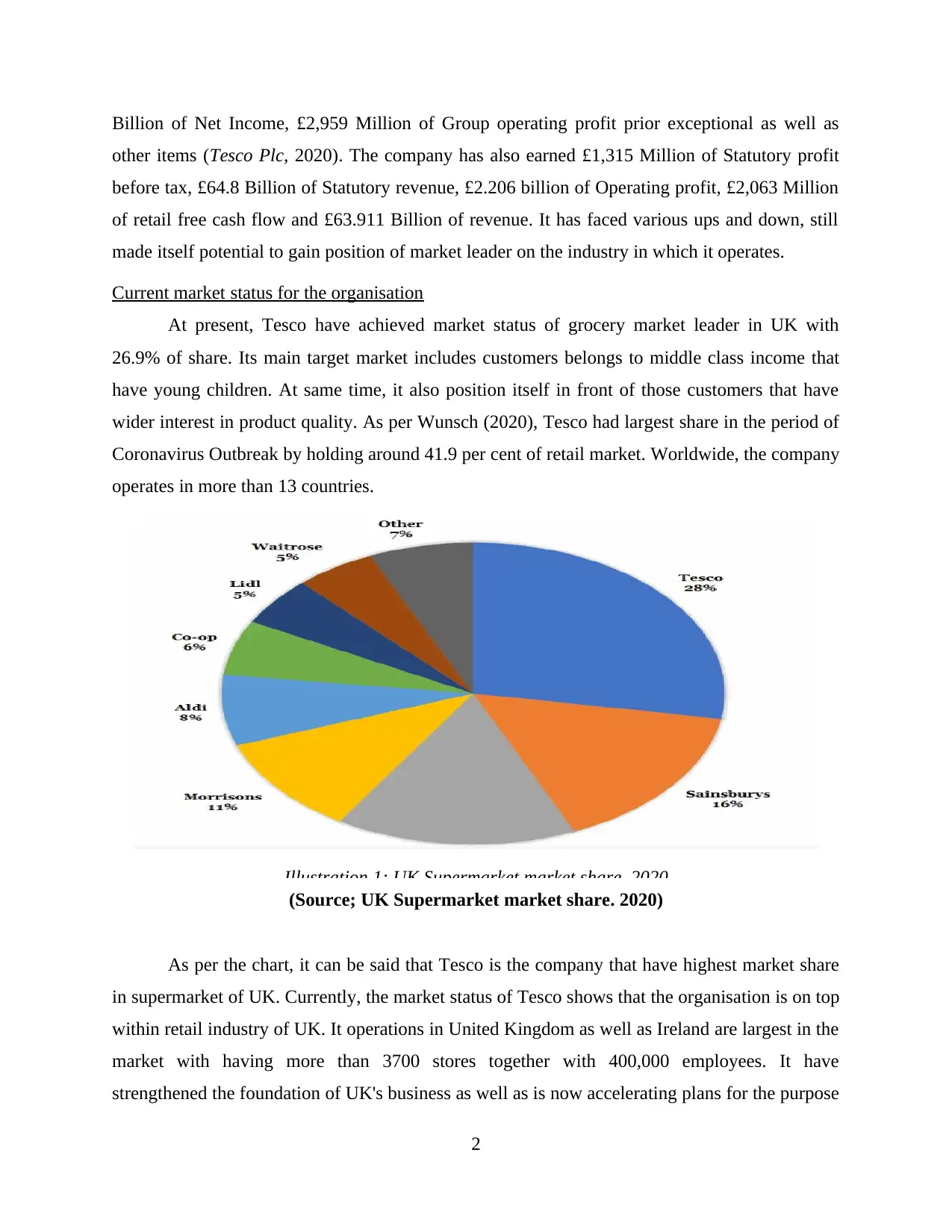
Billion of Net Income, £2,959 Million of Group operating profit prior exceptional as well as
other items (Tesco Plc, 2020). The company has also earned £1,315 Million of Statutory profit
before tax, £64.8 Billion of Statutory revenue, £2.206 billion of Operating profit, £2,063 Million
of retail free cash flow and £63.911 Billion of revenue. It has faced various ups and down, still
made itself potential to gain position of market leader on the industry in which it operates.
Current market status for the organisation
At present, Tesco have achieved market status of grocery market leader in UK with
26.9% of share. Its main target market includes customers belongs to middle class income that
have young children. At same time, it also position itself in front of those customers that have
wider interest in product quality. As per Wunsch (2020), Tesco had largest share in the period of
Coronavirus Outbreak by holding around 41.9 per cent of retail market. Worldwide, the company
operates in more than 13 countries.
Illustration 1: UK Supermarket market share. 2020
(Source; UK Supermarket market share. 2020)
As per the chart, it can be said that Tesco is the company that have highest market share
in supermarket of UK. Currently, the market status of Tesco shows that the organisation is on top
within retail industry of UK. It operations in United Kingdom as well as Ireland are largest in the
market with having more than 3700 stores together with 400,000 employees. It have
strengthened the foundation of UK's business as well as is now accelerating plans for the purpose
2
other items (Tesco Plc, 2020). The company has also earned £1,315 Million of Statutory profit
before tax, £64.8 Billion of Statutory revenue, £2.206 billion of Operating profit, £2,063 Million
of retail free cash flow and £63.911 Billion of revenue. It has faced various ups and down, still
made itself potential to gain position of market leader on the industry in which it operates.
Current market status for the organisation
At present, Tesco have achieved market status of grocery market leader in UK with
26.9% of share. Its main target market includes customers belongs to middle class income that
have young children. At same time, it also position itself in front of those customers that have
wider interest in product quality. As per Wunsch (2020), Tesco had largest share in the period of
Coronavirus Outbreak by holding around 41.9 per cent of retail market. Worldwide, the company
operates in more than 13 countries.
Illustration 1: UK Supermarket market share. 2020
(Source; UK Supermarket market share. 2020)
As per the chart, it can be said that Tesco is the company that have highest market share
in supermarket of UK. Currently, the market status of Tesco shows that the organisation is on top
within retail industry of UK. It operations in United Kingdom as well as Ireland are largest in the
market with having more than 3700 stores together with 400,000 employees. It have
strengthened the foundation of UK's business as well as is now accelerating plans for the purpose
2
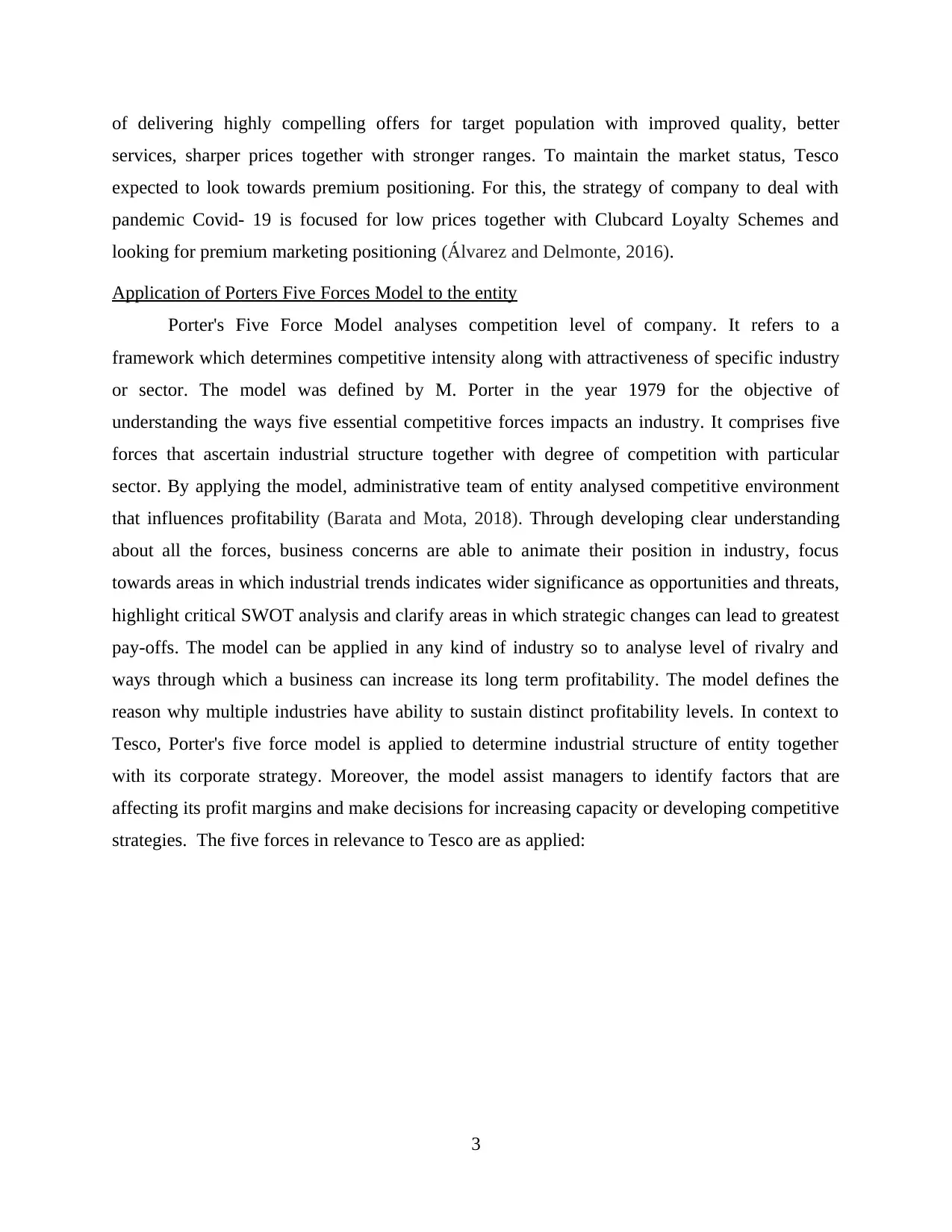
of delivering highly compelling offers for target population with improved quality, better
services, sharper prices together with stronger ranges. To maintain the market status, Tesco
expected to look towards premium positioning. For this, the strategy of company to deal with
pandemic Covid- 19 is focused for low prices together with Clubcard Loyalty Schemes and
looking for premium marketing positioning (Álvarez and Delmonte, 2016).
Application of Porters Five Forces Model to the entity
Porter's Five Force Model analyses competition level of company. It refers to a
framework which determines competitive intensity along with attractiveness of specific industry
or sector. The model was defined by M. Porter in the year 1979 for the objective of
understanding the ways five essential competitive forces impacts an industry. It comprises five
forces that ascertain industrial structure together with degree of competition with particular
sector. By applying the model, administrative team of entity analysed competitive environment
that influences profitability (Barata and Mota, 2018). Through developing clear understanding
about all the forces, business concerns are able to animate their position in industry, focus
towards areas in which industrial trends indicates wider significance as opportunities and threats,
highlight critical SWOT analysis and clarify areas in which strategic changes can lead to greatest
pay-offs. The model can be applied in any kind of industry so to analyse level of rivalry and
ways through which a business can increase its long term profitability. The model defines the
reason why multiple industries have ability to sustain distinct profitability levels. In context to
Tesco, Porter's five force model is applied to determine industrial structure of entity together
with its corporate strategy. Moreover, the model assist managers to identify factors that are
affecting its profit margins and make decisions for increasing capacity or developing competitive
strategies. The five forces in relevance to Tesco are as applied:
3
services, sharper prices together with stronger ranges. To maintain the market status, Tesco
expected to look towards premium positioning. For this, the strategy of company to deal with
pandemic Covid- 19 is focused for low prices together with Clubcard Loyalty Schemes and
looking for premium marketing positioning (Álvarez and Delmonte, 2016).
Application of Porters Five Forces Model to the entity
Porter's Five Force Model analyses competition level of company. It refers to a
framework which determines competitive intensity along with attractiveness of specific industry
or sector. The model was defined by M. Porter in the year 1979 for the objective of
understanding the ways five essential competitive forces impacts an industry. It comprises five
forces that ascertain industrial structure together with degree of competition with particular
sector. By applying the model, administrative team of entity analysed competitive environment
that influences profitability (Barata and Mota, 2018). Through developing clear understanding
about all the forces, business concerns are able to animate their position in industry, focus
towards areas in which industrial trends indicates wider significance as opportunities and threats,
highlight critical SWOT analysis and clarify areas in which strategic changes can lead to greatest
pay-offs. The model can be applied in any kind of industry so to analyse level of rivalry and
ways through which a business can increase its long term profitability. The model defines the
reason why multiple industries have ability to sustain distinct profitability levels. In context to
Tesco, Porter's five force model is applied to determine industrial structure of entity together
with its corporate strategy. Moreover, the model assist managers to identify factors that are
affecting its profit margins and make decisions for increasing capacity or developing competitive
strategies. The five forces in relevance to Tesco are as applied:
3
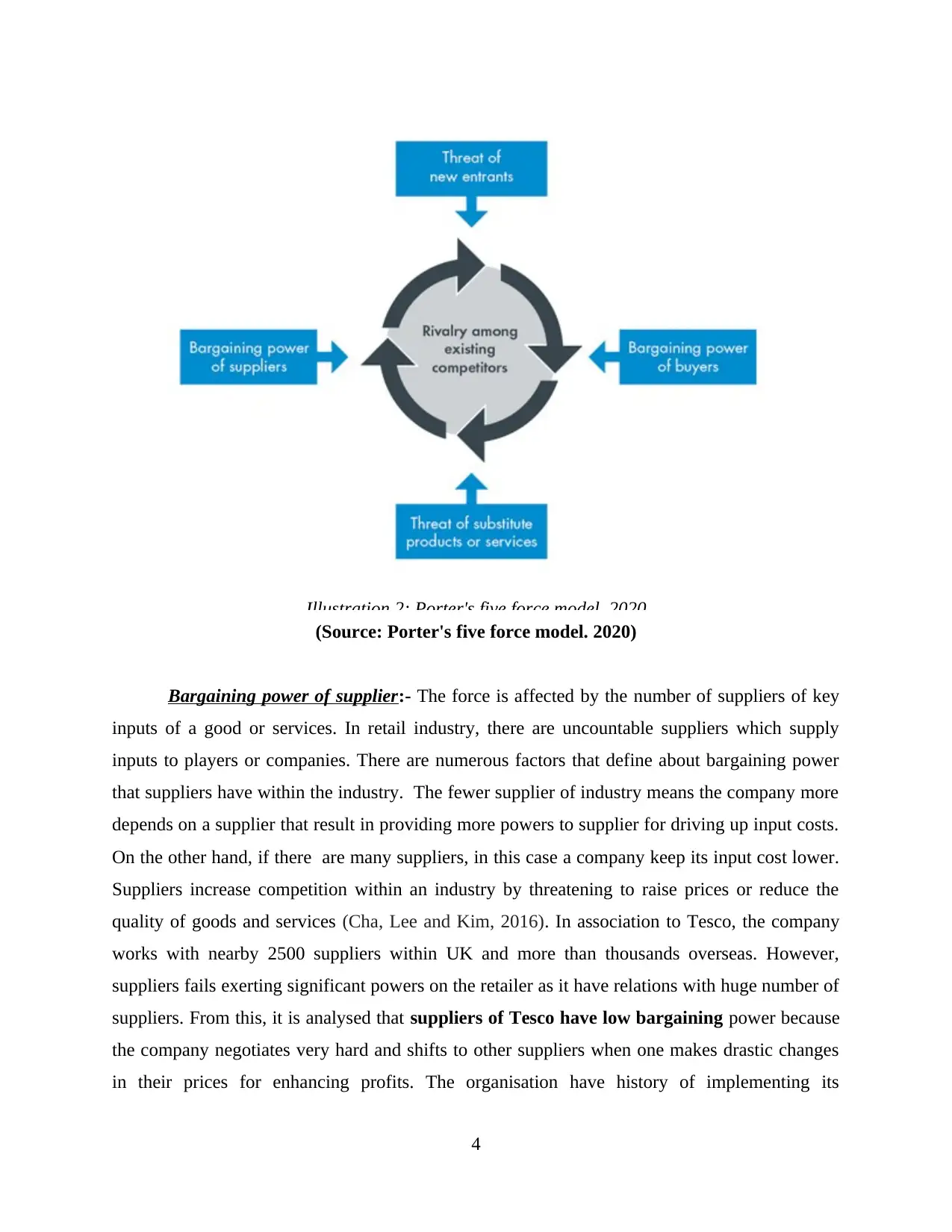
Illustration 2: Porter's five force model. 2020
(Source: Porter's five force model. 2020)
Bargaining power of supplier:- The force is affected by the number of suppliers of key
inputs of a good or services. In retail industry, there are uncountable suppliers which supply
inputs to players or companies. There are numerous factors that define about bargaining power
that suppliers have within the industry. The fewer supplier of industry means the company more
depends on a supplier that result in providing more powers to supplier for driving up input costs.
On the other hand, if there are many suppliers, in this case a company keep its input cost lower.
Suppliers increase competition within an industry by threatening to raise prices or reduce the
quality of goods and services (Cha, Lee and Kim, 2016). In association to Tesco, the company
works with nearby 2500 suppliers within UK and more than thousands overseas. However,
suppliers fails exerting significant powers on the retailer as it have relations with huge number of
suppliers. From this, it is analysed that suppliers of Tesco have low bargaining power because
the company negotiates very hard and shifts to other suppliers when one makes drastic changes
in their prices for enhancing profits. The organisation have history of implementing its
4
(Source: Porter's five force model. 2020)
Bargaining power of supplier:- The force is affected by the number of suppliers of key
inputs of a good or services. In retail industry, there are uncountable suppliers which supply
inputs to players or companies. There are numerous factors that define about bargaining power
that suppliers have within the industry. The fewer supplier of industry means the company more
depends on a supplier that result in providing more powers to supplier for driving up input costs.
On the other hand, if there are many suppliers, in this case a company keep its input cost lower.
Suppliers increase competition within an industry by threatening to raise prices or reduce the
quality of goods and services (Cha, Lee and Kim, 2016). In association to Tesco, the company
works with nearby 2500 suppliers within UK and more than thousands overseas. However,
suppliers fails exerting significant powers on the retailer as it have relations with huge number of
suppliers. From this, it is analysed that suppliers of Tesco have low bargaining power because
the company negotiates very hard and shifts to other suppliers when one makes drastic changes
in their prices for enhancing profits. The organisation have history of implementing its
4
Paraphrase This Document
Need a fresh take? Get an instant paraphrase of this document with our AI Paraphraser
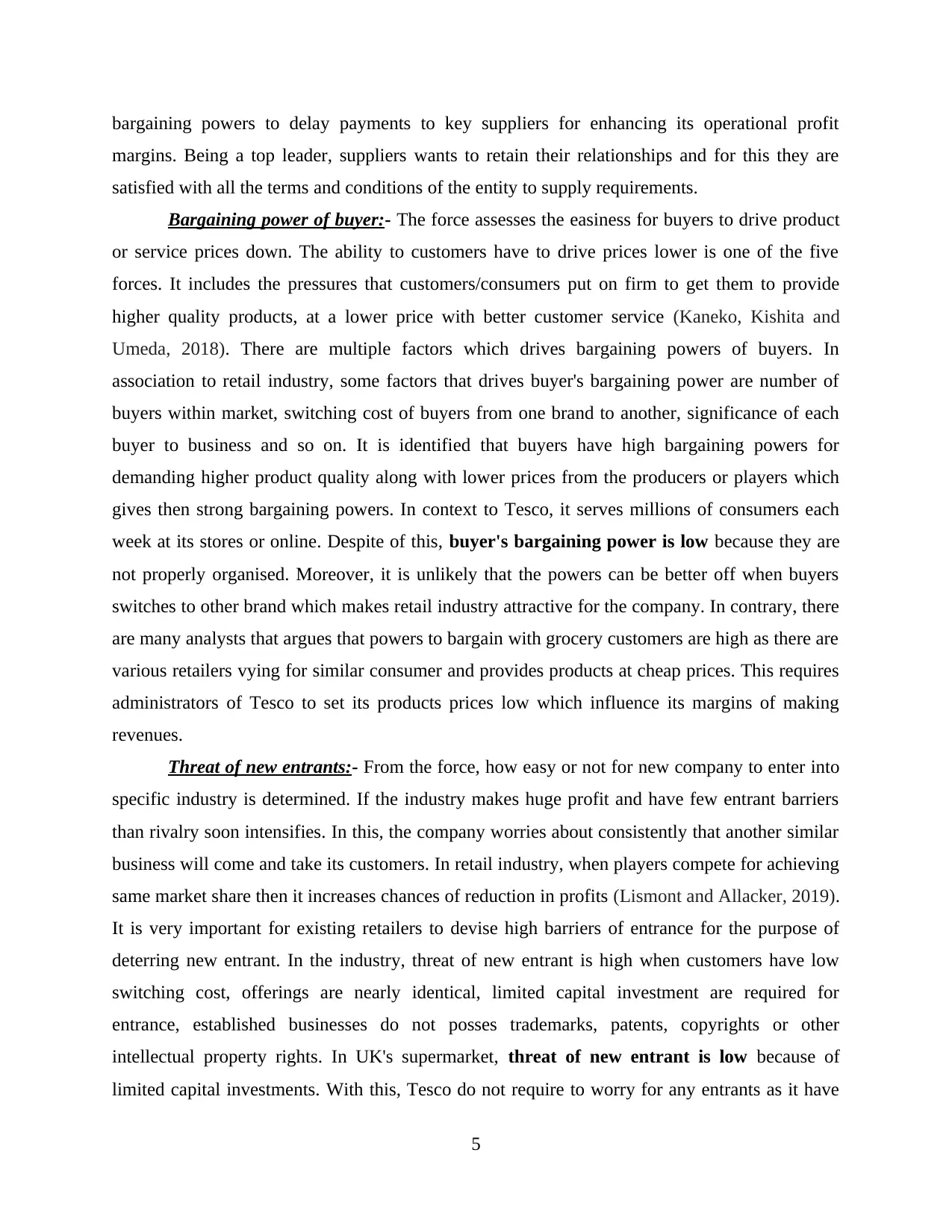
bargaining powers to delay payments to key suppliers for enhancing its operational profit
margins. Being a top leader, suppliers wants to retain their relationships and for this they are
satisfied with all the terms and conditions of the entity to supply requirements.
Bargaining power of buyer:- The force assesses the easiness for buyers to drive product
or service prices down. The ability to customers have to drive prices lower is one of the five
forces. It includes the pressures that customers/consumers put on firm to get them to provide
higher quality products, at a lower price with better customer service (Kaneko, Kishita and
Umeda, 2018). There are multiple factors which drives bargaining powers of buyers. In
association to retail industry, some factors that drives buyer's bargaining power are number of
buyers within market, switching cost of buyers from one brand to another, significance of each
buyer to business and so on. It is identified that buyers have high bargaining powers for
demanding higher product quality along with lower prices from the producers or players which
gives then strong bargaining powers. In context to Tesco, it serves millions of consumers each
week at its stores or online. Despite of this, buyer's bargaining power is low because they are
not properly organised. Moreover, it is unlikely that the powers can be better off when buyers
switches to other brand which makes retail industry attractive for the company. In contrary, there
are many analysts that argues that powers to bargain with grocery customers are high as there are
various retailers vying for similar consumer and provides products at cheap prices. This requires
administrators of Tesco to set its products prices low which influence its margins of making
revenues.
Threat of new entrants:- From the force, how easy or not for new company to enter into
specific industry is determined. If the industry makes huge profit and have few entrant barriers
than rivalry soon intensifies. In this, the company worries about consistently that another similar
business will come and take its customers. In retail industry, when players compete for achieving
same market share then it increases chances of reduction in profits (Lismont and Allacker, 2019).
It is very important for existing retailers to devise high barriers of entrance for the purpose of
deterring new entrant. In the industry, threat of new entrant is high when customers have low
switching cost, offerings are nearly identical, limited capital investment are required for
entrance, established businesses do not posses trademarks, patents, copyrights or other
intellectual property rights. In UK's supermarket, threat of new entrant is low because of
limited capital investments. With this, Tesco do not require to worry for any entrants as it have
5
margins. Being a top leader, suppliers wants to retain their relationships and for this they are
satisfied with all the terms and conditions of the entity to supply requirements.
Bargaining power of buyer:- The force assesses the easiness for buyers to drive product
or service prices down. The ability to customers have to drive prices lower is one of the five
forces. It includes the pressures that customers/consumers put on firm to get them to provide
higher quality products, at a lower price with better customer service (Kaneko, Kishita and
Umeda, 2018). There are multiple factors which drives bargaining powers of buyers. In
association to retail industry, some factors that drives buyer's bargaining power are number of
buyers within market, switching cost of buyers from one brand to another, significance of each
buyer to business and so on. It is identified that buyers have high bargaining powers for
demanding higher product quality along with lower prices from the producers or players which
gives then strong bargaining powers. In context to Tesco, it serves millions of consumers each
week at its stores or online. Despite of this, buyer's bargaining power is low because they are
not properly organised. Moreover, it is unlikely that the powers can be better off when buyers
switches to other brand which makes retail industry attractive for the company. In contrary, there
are many analysts that argues that powers to bargain with grocery customers are high as there are
various retailers vying for similar consumer and provides products at cheap prices. This requires
administrators of Tesco to set its products prices low which influence its margins of making
revenues.
Threat of new entrants:- From the force, how easy or not for new company to enter into
specific industry is determined. If the industry makes huge profit and have few entrant barriers
than rivalry soon intensifies. In this, the company worries about consistently that another similar
business will come and take its customers. In retail industry, when players compete for achieving
same market share then it increases chances of reduction in profits (Lismont and Allacker, 2019).
It is very important for existing retailers to devise high barriers of entrance for the purpose of
deterring new entrant. In the industry, threat of new entrant is high when customers have low
switching cost, offerings are nearly identical, limited capital investment are required for
entrance, established businesses do not posses trademarks, patents, copyrights or other
intellectual property rights. In UK's supermarket, threat of new entrant is low because of
limited capital investments. With this, Tesco do not require to worry for any entrants as it have
5
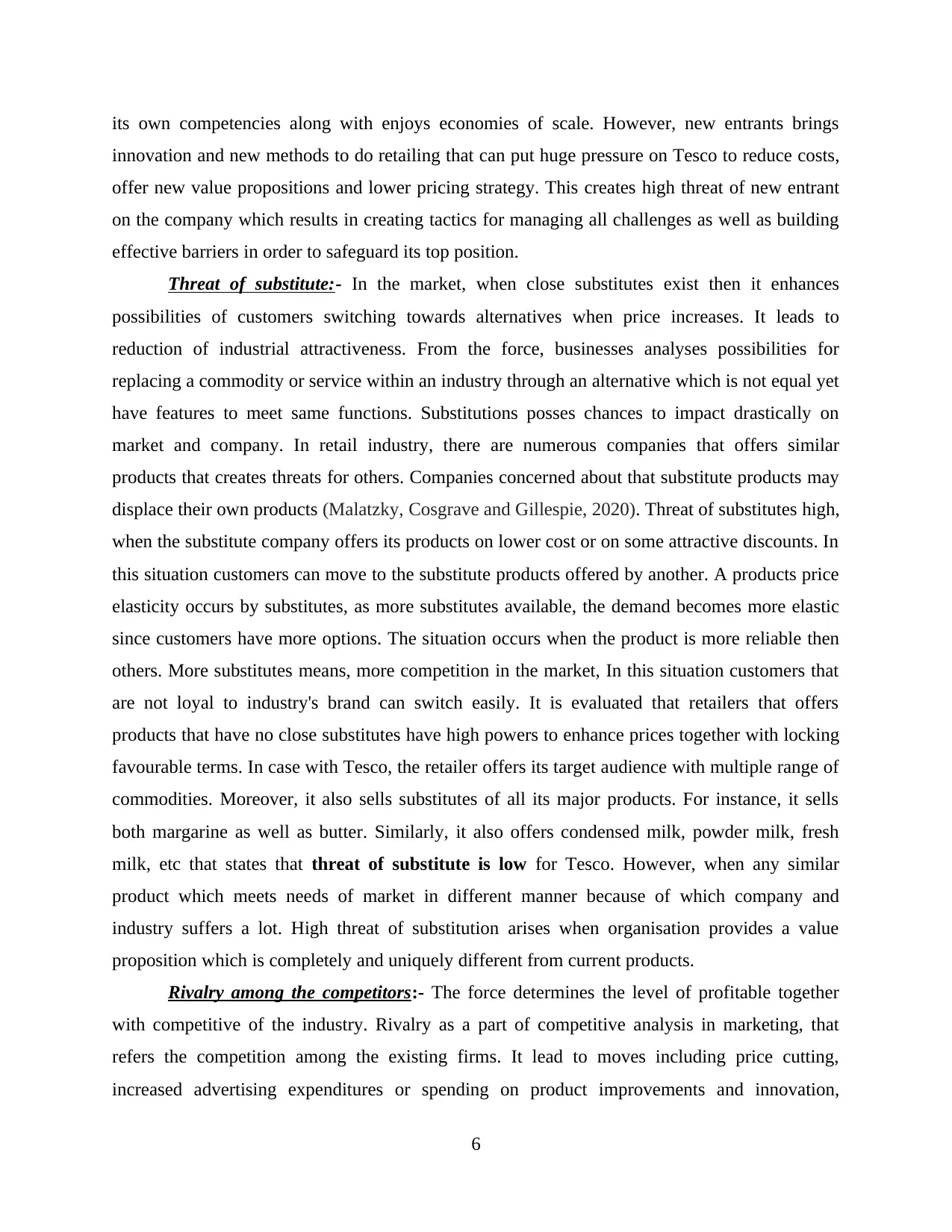
its own competencies along with enjoys economies of scale. However, new entrants brings
innovation and new methods to do retailing that can put huge pressure on Tesco to reduce costs,
offer new value propositions and lower pricing strategy. This creates high threat of new entrant
on the company which results in creating tactics for managing all challenges as well as building
effective barriers in order to safeguard its top position.
Threat of substitute:- In the market, when close substitutes exist then it enhances
possibilities of customers switching towards alternatives when price increases. It leads to
reduction of industrial attractiveness. From the force, businesses analyses possibilities for
replacing a commodity or service within an industry through an alternative which is not equal yet
have features to meet same functions. Substitutions posses chances to impact drastically on
market and company. In retail industry, there are numerous companies that offers similar
products that creates threats for others. Companies concerned about that substitute products may
displace their own products (Malatzky, Cosgrave and Gillespie, 2020). Threat of substitutes high,
when the substitute company offers its products on lower cost or on some attractive discounts. In
this situation customers can move to the substitute products offered by another. A products price
elasticity occurs by substitutes, as more substitutes available, the demand becomes more elastic
since customers have more options. The situation occurs when the product is more reliable then
others. More substitutes means, more competition in the market, In this situation customers that
are not loyal to industry's brand can switch easily. It is evaluated that retailers that offers
products that have no close substitutes have high powers to enhance prices together with locking
favourable terms. In case with Tesco, the retailer offers its target audience with multiple range of
commodities. Moreover, it also sells substitutes of all its major products. For instance, it sells
both margarine as well as butter. Similarly, it also offers condensed milk, powder milk, fresh
milk, etc that states that threat of substitute is low for Tesco. However, when any similar
product which meets needs of market in different manner because of which company and
industry suffers a lot. High threat of substitution arises when organisation provides a value
proposition which is completely and uniquely different from current products.
Rivalry among the competitors:- The force determines the level of profitable together
with competitive of the industry. Rivalry as a part of competitive analysis in marketing, that
refers the competition among the existing firms. It lead to moves including price cutting,
increased advertising expenditures or spending on product improvements and innovation,
6
innovation and new methods to do retailing that can put huge pressure on Tesco to reduce costs,
offer new value propositions and lower pricing strategy. This creates high threat of new entrant
on the company which results in creating tactics for managing all challenges as well as building
effective barriers in order to safeguard its top position.
Threat of substitute:- In the market, when close substitutes exist then it enhances
possibilities of customers switching towards alternatives when price increases. It leads to
reduction of industrial attractiveness. From the force, businesses analyses possibilities for
replacing a commodity or service within an industry through an alternative which is not equal yet
have features to meet same functions. Substitutions posses chances to impact drastically on
market and company. In retail industry, there are numerous companies that offers similar
products that creates threats for others. Companies concerned about that substitute products may
displace their own products (Malatzky, Cosgrave and Gillespie, 2020). Threat of substitutes high,
when the substitute company offers its products on lower cost or on some attractive discounts. In
this situation customers can move to the substitute products offered by another. A products price
elasticity occurs by substitutes, as more substitutes available, the demand becomes more elastic
since customers have more options. The situation occurs when the product is more reliable then
others. More substitutes means, more competition in the market, In this situation customers that
are not loyal to industry's brand can switch easily. It is evaluated that retailers that offers
products that have no close substitutes have high powers to enhance prices together with locking
favourable terms. In case with Tesco, the retailer offers its target audience with multiple range of
commodities. Moreover, it also sells substitutes of all its major products. For instance, it sells
both margarine as well as butter. Similarly, it also offers condensed milk, powder milk, fresh
milk, etc that states that threat of substitute is low for Tesco. However, when any similar
product which meets needs of market in different manner because of which company and
industry suffers a lot. High threat of substitution arises when organisation provides a value
proposition which is completely and uniquely different from current products.
Rivalry among the competitors:- The force determines the level of profitable together
with competitive of the industry. Rivalry as a part of competitive analysis in marketing, that
refers the competition among the existing firms. It lead to moves including price cutting,
increased advertising expenditures or spending on product improvements and innovation,
6
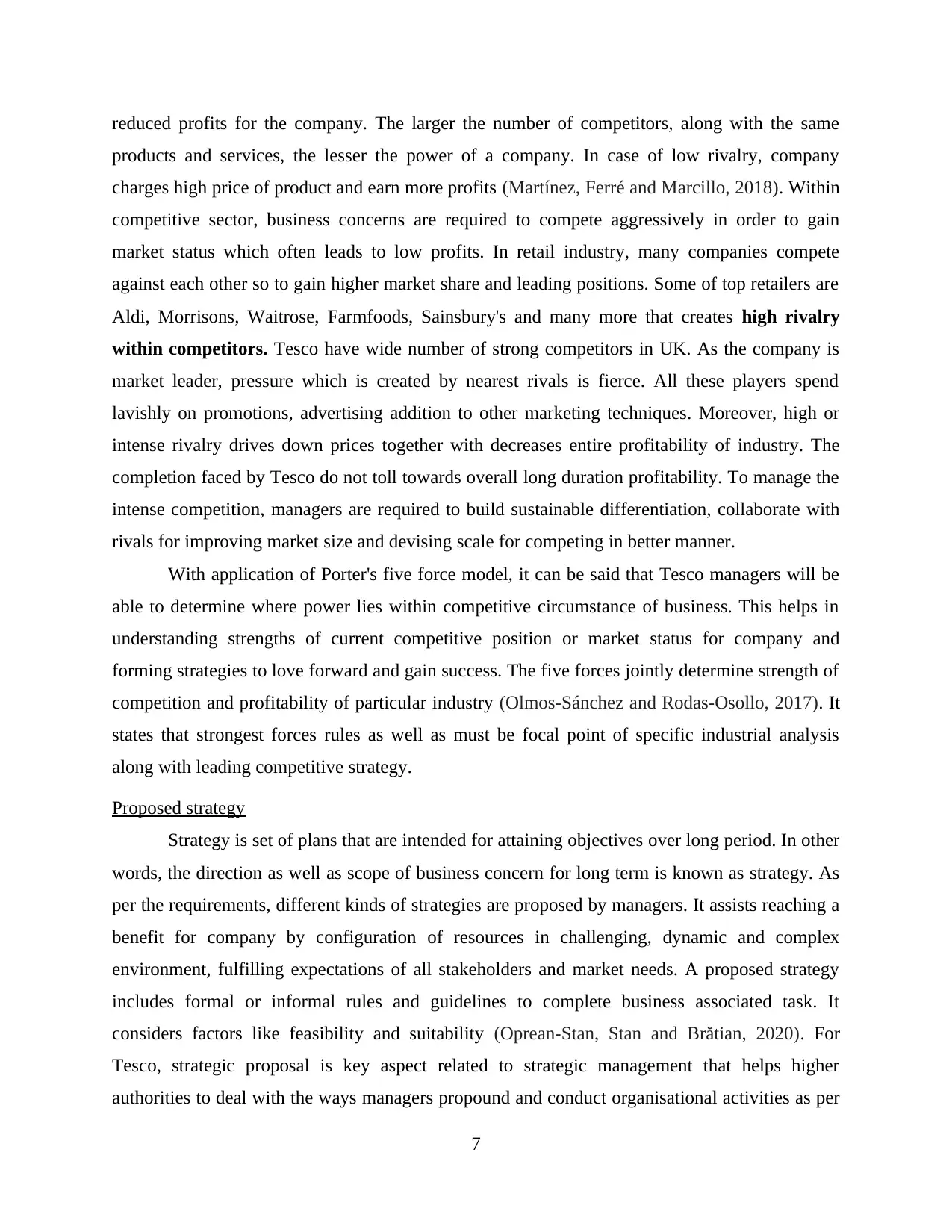
reduced profits for the company. The larger the number of competitors, along with the same
products and services, the lesser the power of a company. In case of low rivalry, company
charges high price of product and earn more profits (Martínez, Ferré and Marcillo, 2018). Within
competitive sector, business concerns are required to compete aggressively in order to gain
market status which often leads to low profits. In retail industry, many companies compete
against each other so to gain higher market share and leading positions. Some of top retailers are
Aldi, Morrisons, Waitrose, Farmfoods, Sainsbury's and many more that creates high rivalry
within competitors. Tesco have wide number of strong competitors in UK. As the company is
market leader, pressure which is created by nearest rivals is fierce. All these players spend
lavishly on promotions, advertising addition to other marketing techniques. Moreover, high or
intense rivalry drives down prices together with decreases entire profitability of industry. The
completion faced by Tesco do not toll towards overall long duration profitability. To manage the
intense competition, managers are required to build sustainable differentiation, collaborate with
rivals for improving market size and devising scale for competing in better manner.
With application of Porter's five force model, it can be said that Tesco managers will be
able to determine where power lies within competitive circumstance of business. This helps in
understanding strengths of current competitive position or market status for company and
forming strategies to love forward and gain success. The five forces jointly determine strength of
competition and profitability of particular industry (Olmos-Sánchez and Rodas-Osollo, 2017). It
states that strongest forces rules as well as must be focal point of specific industrial analysis
along with leading competitive strategy.
Proposed strategy
Strategy is set of plans that are intended for attaining objectives over long period. In other
words, the direction as well as scope of business concern for long term is known as strategy. As
per the requirements, different kinds of strategies are proposed by managers. It assists reaching a
benefit for company by configuration of resources in challenging, dynamic and complex
environment, fulfilling expectations of all stakeholders and market needs. A proposed strategy
includes formal or informal rules and guidelines to complete business associated task. It
considers factors like feasibility and suitability (Oprean-Stan, Stan and Brătian, 2020). For
Tesco, strategic proposal is key aspect related to strategic management that helps higher
authorities to deal with the ways managers propound and conduct organisational activities as per
7
products and services, the lesser the power of a company. In case of low rivalry, company
charges high price of product and earn more profits (Martínez, Ferré and Marcillo, 2018). Within
competitive sector, business concerns are required to compete aggressively in order to gain
market status which often leads to low profits. In retail industry, many companies compete
against each other so to gain higher market share and leading positions. Some of top retailers are
Aldi, Morrisons, Waitrose, Farmfoods, Sainsbury's and many more that creates high rivalry
within competitors. Tesco have wide number of strong competitors in UK. As the company is
market leader, pressure which is created by nearest rivals is fierce. All these players spend
lavishly on promotions, advertising addition to other marketing techniques. Moreover, high or
intense rivalry drives down prices together with decreases entire profitability of industry. The
completion faced by Tesco do not toll towards overall long duration profitability. To manage the
intense competition, managers are required to build sustainable differentiation, collaborate with
rivals for improving market size and devising scale for competing in better manner.
With application of Porter's five force model, it can be said that Tesco managers will be
able to determine where power lies within competitive circumstance of business. This helps in
understanding strengths of current competitive position or market status for company and
forming strategies to love forward and gain success. The five forces jointly determine strength of
competition and profitability of particular industry (Olmos-Sánchez and Rodas-Osollo, 2017). It
states that strongest forces rules as well as must be focal point of specific industrial analysis
along with leading competitive strategy.
Proposed strategy
Strategy is set of plans that are intended for attaining objectives over long period. In other
words, the direction as well as scope of business concern for long term is known as strategy. As
per the requirements, different kinds of strategies are proposed by managers. It assists reaching a
benefit for company by configuration of resources in challenging, dynamic and complex
environment, fulfilling expectations of all stakeholders and market needs. A proposed strategy
includes formal or informal rules and guidelines to complete business associated task. It
considers factors like feasibility and suitability (Oprean-Stan, Stan and Brătian, 2020). For
Tesco, strategic proposal is key aspect related to strategic management that helps higher
authorities to deal with the ways managers propound and conduct organisational activities as per
7
Secure Best Marks with AI Grader
Need help grading? Try our AI Grader for instant feedback on your assignments.
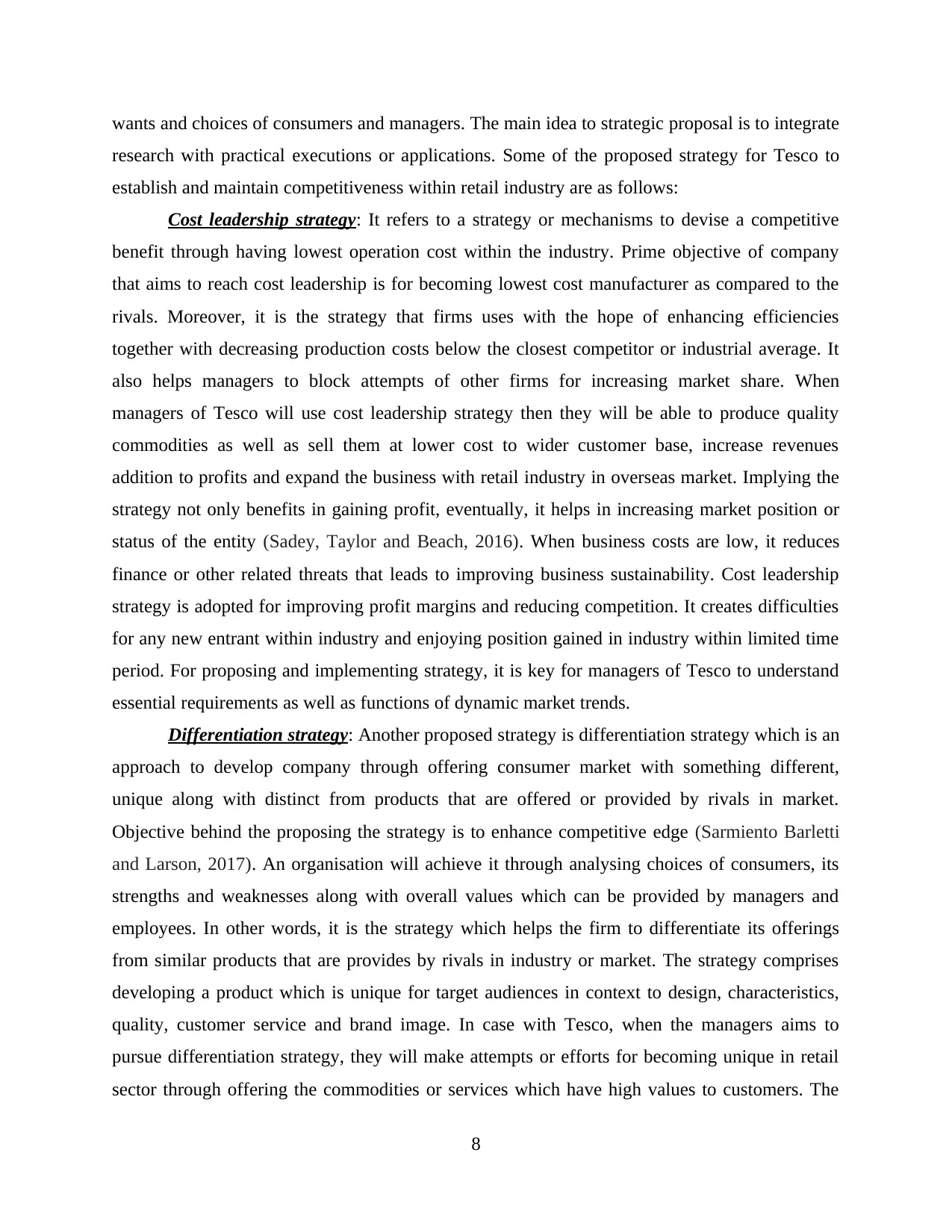
wants and choices of consumers and managers. The main idea to strategic proposal is to integrate
research with practical executions or applications. Some of the proposed strategy for Tesco to
establish and maintain competitiveness within retail industry are as follows:
Cost leadership strategy: It refers to a strategy or mechanisms to devise a competitive
benefit through having lowest operation cost within the industry. Prime objective of company
that aims to reach cost leadership is for becoming lowest cost manufacturer as compared to the
rivals. Moreover, it is the strategy that firms uses with the hope of enhancing efficiencies
together with decreasing production costs below the closest competitor or industrial average. It
also helps managers to block attempts of other firms for increasing market share. When
managers of Tesco will use cost leadership strategy then they will be able to produce quality
commodities as well as sell them at lower cost to wider customer base, increase revenues
addition to profits and expand the business with retail industry in overseas market. Implying the
strategy not only benefits in gaining profit, eventually, it helps in increasing market position or
status of the entity (Sadey, Taylor and Beach, 2016). When business costs are low, it reduces
finance or other related threats that leads to improving business sustainability. Cost leadership
strategy is adopted for improving profit margins and reducing competition. It creates difficulties
for any new entrant within industry and enjoying position gained in industry within limited time
period. For proposing and implementing strategy, it is key for managers of Tesco to understand
essential requirements as well as functions of dynamic market trends.
Differentiation strategy: Another proposed strategy is differentiation strategy which is an
approach to develop company through offering consumer market with something different,
unique along with distinct from products that are offered or provided by rivals in market.
Objective behind the proposing the strategy is to enhance competitive edge (Sarmiento Barletti
and Larson, 2017). An organisation will achieve it through analysing choices of consumers, its
strengths and weaknesses along with overall values which can be provided by managers and
employees. In other words, it is the strategy which helps the firm to differentiate its offerings
from similar products that are provides by rivals in industry or market. The strategy comprises
developing a product which is unique for target audiences in context to design, characteristics,
quality, customer service and brand image. In case with Tesco, when the managers aims to
pursue differentiation strategy, they will make attempts or efforts for becoming unique in retail
sector through offering the commodities or services which have high values to customers. The
8
research with practical executions or applications. Some of the proposed strategy for Tesco to
establish and maintain competitiveness within retail industry are as follows:
Cost leadership strategy: It refers to a strategy or mechanisms to devise a competitive
benefit through having lowest operation cost within the industry. Prime objective of company
that aims to reach cost leadership is for becoming lowest cost manufacturer as compared to the
rivals. Moreover, it is the strategy that firms uses with the hope of enhancing efficiencies
together with decreasing production costs below the closest competitor or industrial average. It
also helps managers to block attempts of other firms for increasing market share. When
managers of Tesco will use cost leadership strategy then they will be able to produce quality
commodities as well as sell them at lower cost to wider customer base, increase revenues
addition to profits and expand the business with retail industry in overseas market. Implying the
strategy not only benefits in gaining profit, eventually, it helps in increasing market position or
status of the entity (Sadey, Taylor and Beach, 2016). When business costs are low, it reduces
finance or other related threats that leads to improving business sustainability. Cost leadership
strategy is adopted for improving profit margins and reducing competition. It creates difficulties
for any new entrant within industry and enjoying position gained in industry within limited time
period. For proposing and implementing strategy, it is key for managers of Tesco to understand
essential requirements as well as functions of dynamic market trends.
Differentiation strategy: Another proposed strategy is differentiation strategy which is an
approach to develop company through offering consumer market with something different,
unique along with distinct from products that are offered or provided by rivals in market.
Objective behind the proposing the strategy is to enhance competitive edge (Sarmiento Barletti
and Larson, 2017). An organisation will achieve it through analysing choices of consumers, its
strengths and weaknesses along with overall values which can be provided by managers and
employees. In other words, it is the strategy which helps the firm to differentiate its offerings
from similar products that are provides by rivals in industry or market. The strategy comprises
developing a product which is unique for target audiences in context to design, characteristics,
quality, customer service and brand image. In case with Tesco, when the managers aims to
pursue differentiation strategy, they will make attempts or efforts for becoming unique in retail
sector through offering the commodities or services which have high values to customers. The
8
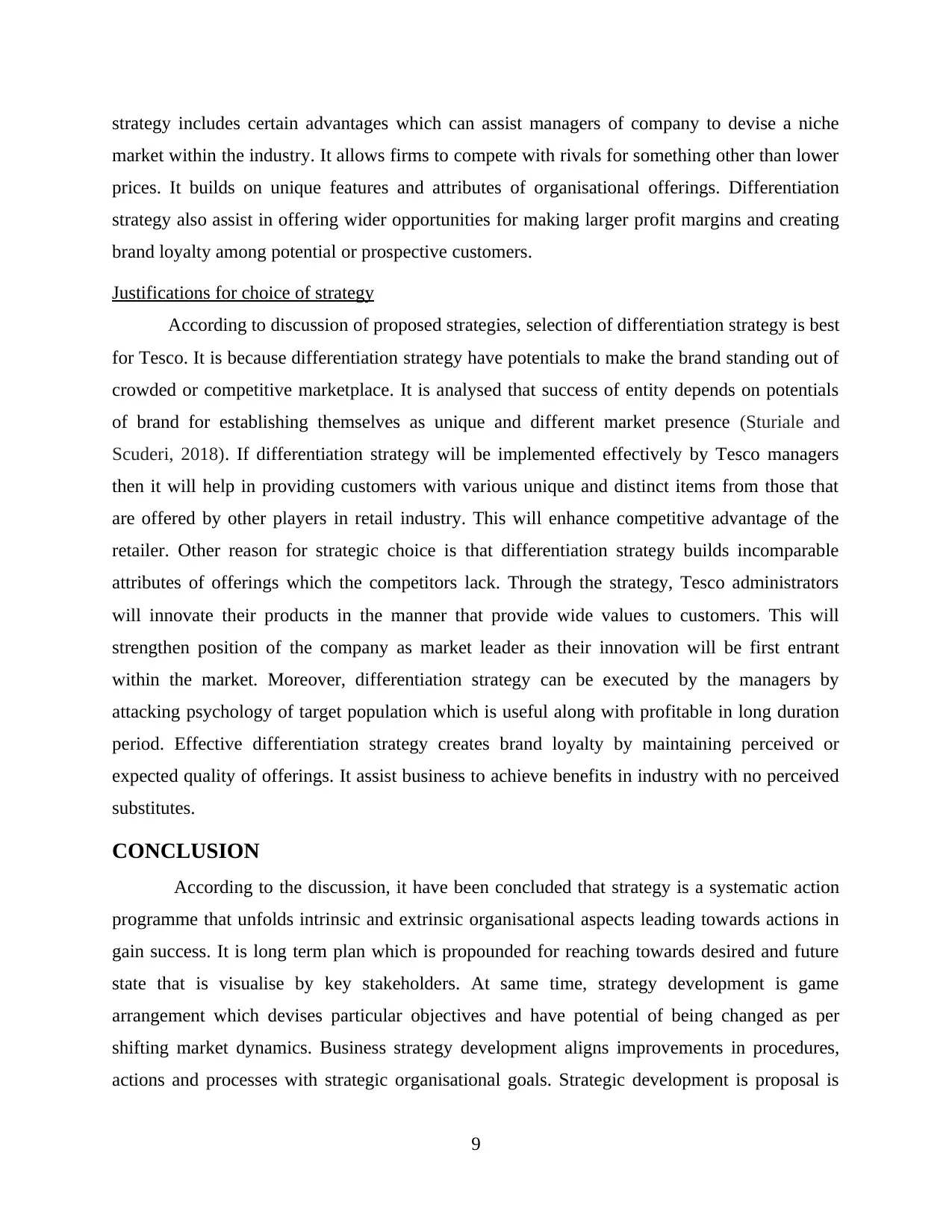
strategy includes certain advantages which can assist managers of company to devise a niche
market within the industry. It allows firms to compete with rivals for something other than lower
prices. It builds on unique features and attributes of organisational offerings. Differentiation
strategy also assist in offering wider opportunities for making larger profit margins and creating
brand loyalty among potential or prospective customers.
Justifications for choice of strategy
According to discussion of proposed strategies, selection of differentiation strategy is best
for Tesco. It is because differentiation strategy have potentials to make the brand standing out of
crowded or competitive marketplace. It is analysed that success of entity depends on potentials
of brand for establishing themselves as unique and different market presence (Sturiale and
Scuderi, 2018). If differentiation strategy will be implemented effectively by Tesco managers
then it will help in providing customers with various unique and distinct items from those that
are offered by other players in retail industry. This will enhance competitive advantage of the
retailer. Other reason for strategic choice is that differentiation strategy builds incomparable
attributes of offerings which the competitors lack. Through the strategy, Tesco administrators
will innovate their products in the manner that provide wide values to customers. This will
strengthen position of the company as market leader as their innovation will be first entrant
within the market. Moreover, differentiation strategy can be executed by the managers by
attacking psychology of target population which is useful along with profitable in long duration
period. Effective differentiation strategy creates brand loyalty by maintaining perceived or
expected quality of offerings. It assist business to achieve benefits in industry with no perceived
substitutes.
CONCLUSION
According to the discussion, it have been concluded that strategy is a systematic action
programme that unfolds intrinsic and extrinsic organisational aspects leading towards actions in
gain success. It is long term plan which is propounded for reaching towards desired and future
state that is visualise by key stakeholders. At same time, strategy development is game
arrangement which devises particular objectives and have potential of being changed as per
shifting market dynamics. Business strategy development aligns improvements in procedures,
actions and processes with strategic organisational goals. Strategic development is proposal is
9
market within the industry. It allows firms to compete with rivals for something other than lower
prices. It builds on unique features and attributes of organisational offerings. Differentiation
strategy also assist in offering wider opportunities for making larger profit margins and creating
brand loyalty among potential or prospective customers.
Justifications for choice of strategy
According to discussion of proposed strategies, selection of differentiation strategy is best
for Tesco. It is because differentiation strategy have potentials to make the brand standing out of
crowded or competitive marketplace. It is analysed that success of entity depends on potentials
of brand for establishing themselves as unique and different market presence (Sturiale and
Scuderi, 2018). If differentiation strategy will be implemented effectively by Tesco managers
then it will help in providing customers with various unique and distinct items from those that
are offered by other players in retail industry. This will enhance competitive advantage of the
retailer. Other reason for strategic choice is that differentiation strategy builds incomparable
attributes of offerings which the competitors lack. Through the strategy, Tesco administrators
will innovate their products in the manner that provide wide values to customers. This will
strengthen position of the company as market leader as their innovation will be first entrant
within the market. Moreover, differentiation strategy can be executed by the managers by
attacking psychology of target population which is useful along with profitable in long duration
period. Effective differentiation strategy creates brand loyalty by maintaining perceived or
expected quality of offerings. It assist business to achieve benefits in industry with no perceived
substitutes.
CONCLUSION
According to the discussion, it have been concluded that strategy is a systematic action
programme that unfolds intrinsic and extrinsic organisational aspects leading towards actions in
gain success. It is long term plan which is propounded for reaching towards desired and future
state that is visualise by key stakeholders. At same time, strategy development is game
arrangement which devises particular objectives and have potential of being changed as per
shifting market dynamics. Business strategy development aligns improvements in procedures,
actions and processes with strategic organisational goals. Strategic development is proposal is
9
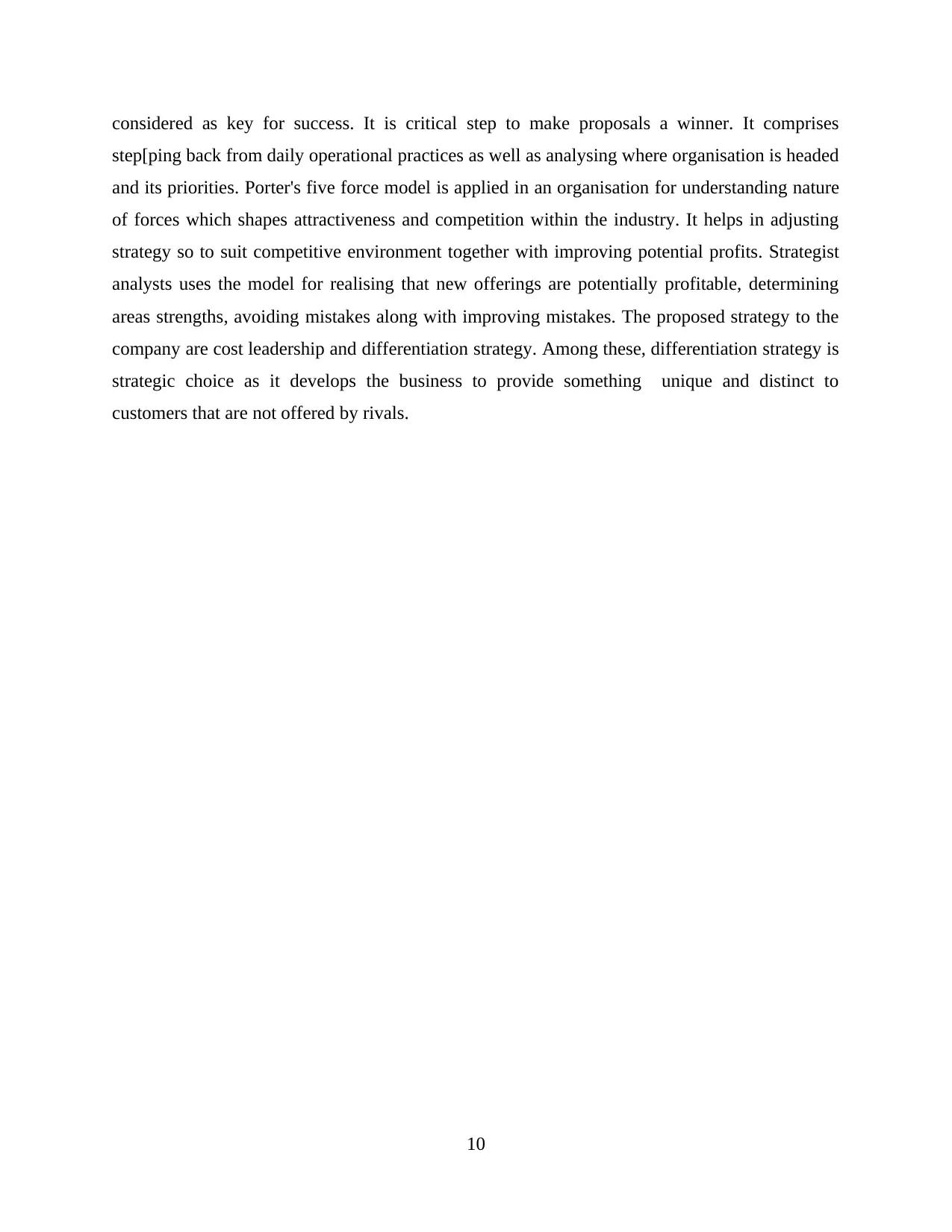
considered as key for success. It is critical step to make proposals a winner. It comprises
step[ping back from daily operational practices as well as analysing where organisation is headed
and its priorities. Porter's five force model is applied in an organisation for understanding nature
of forces which shapes attractiveness and competition within the industry. It helps in adjusting
strategy so to suit competitive environment together with improving potential profits. Strategist
analysts uses the model for realising that new offerings are potentially profitable, determining
areas strengths, avoiding mistakes along with improving mistakes. The proposed strategy to the
company are cost leadership and differentiation strategy. Among these, differentiation strategy is
strategic choice as it develops the business to provide something unique and distinct to
customers that are not offered by rivals.
10
step[ping back from daily operational practices as well as analysing where organisation is headed
and its priorities. Porter's five force model is applied in an organisation for understanding nature
of forces which shapes attractiveness and competition within the industry. It helps in adjusting
strategy so to suit competitive environment together with improving potential profits. Strategist
analysts uses the model for realising that new offerings are potentially profitable, determining
areas strengths, avoiding mistakes along with improving mistakes. The proposed strategy to the
company are cost leadership and differentiation strategy. Among these, differentiation strategy is
strategic choice as it develops the business to provide something unique and distinct to
customers that are not offered by rivals.
10
Paraphrase This Document
Need a fresh take? Get an instant paraphrase of this document with our AI Paraphraser
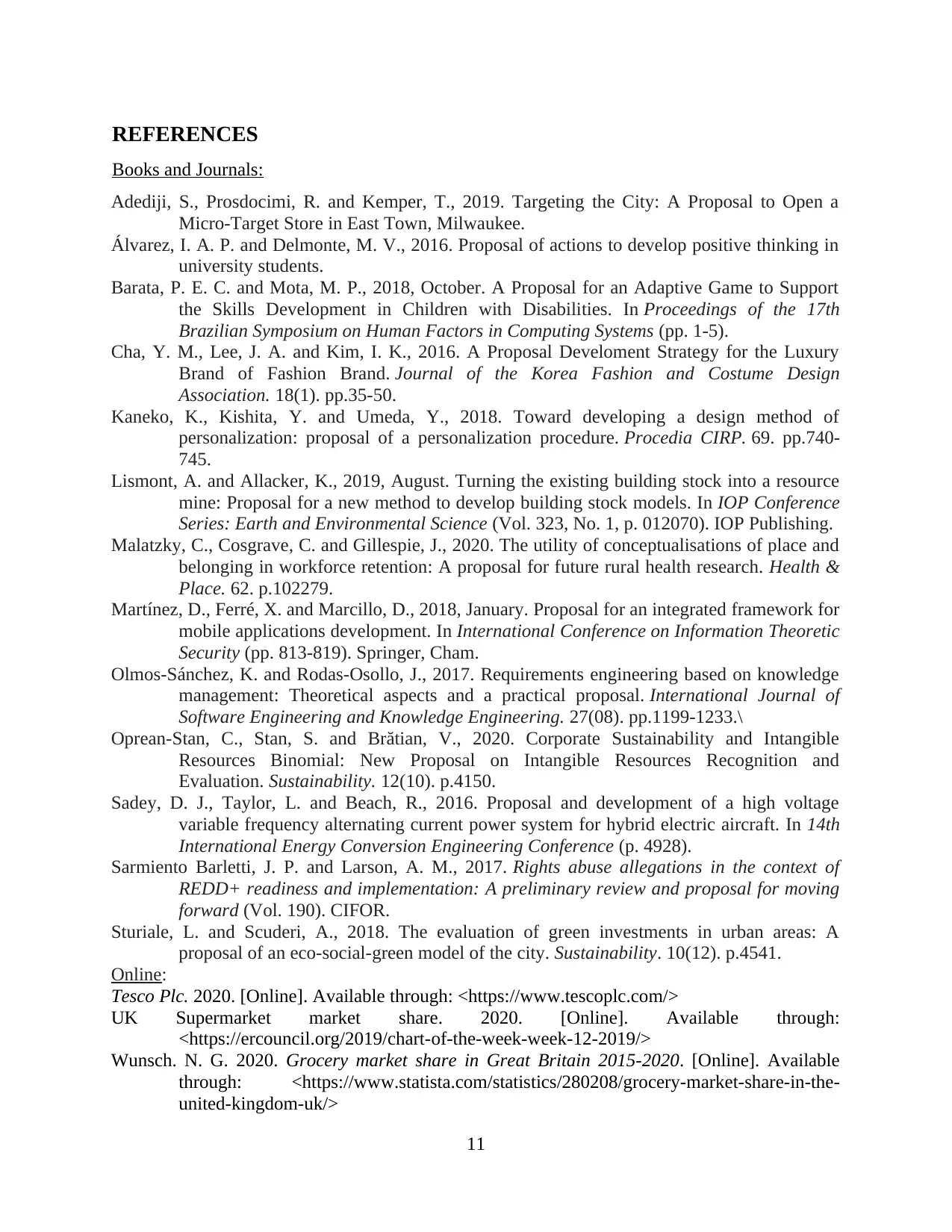
REFERENCES
Books and Journals:
Adediji, S., Prosdocimi, R. and Kemper, T., 2019. Targeting the City: A Proposal to Open a
Micro-Target Store in East Town, Milwaukee.
Álvarez, I. A. P. and Delmonte, M. V., 2016. Proposal of actions to develop positive thinking in
university students.
Barata, P. E. C. and Mota, M. P., 2018, October. A Proposal for an Adaptive Game to Support
the Skills Development in Children with Disabilities. In Proceedings of the 17th
Brazilian Symposium on Human Factors in Computing Systems (pp. 1-5).
Cha, Y. M., Lee, J. A. and Kim, I. K., 2016. A Proposal Develoment Strategy for the Luxury
Brand of Fashion Brand. Journal of the Korea Fashion and Costume Design
Association. 18(1). pp.35-50.
Kaneko, K., Kishita, Y. and Umeda, Y., 2018. Toward developing a design method of
personalization: proposal of a personalization procedure. Procedia CIRP. 69. pp.740-
745.
Lismont, A. and Allacker, K., 2019, August. Turning the existing building stock into a resource
mine: Proposal for a new method to develop building stock models. In IOP Conference
Series: Earth and Environmental Science (Vol. 323, No. 1, p. 012070). IOP Publishing.
Malatzky, C., Cosgrave, C. and Gillespie, J., 2020. The utility of conceptualisations of place and
belonging in workforce retention: A proposal for future rural health research. Health &
Place. 62. p.102279.
Martínez, D., Ferré, X. and Marcillo, D., 2018, January. Proposal for an integrated framework for
mobile applications development. In International Conference on Information Theoretic
Security (pp. 813-819). Springer, Cham.
Olmos-Sánchez, K. and Rodas-Osollo, J., 2017. Requirements engineering based on knowledge
management: Theoretical aspects and a practical proposal. International Journal of
Software Engineering and Knowledge Engineering. 27(08). pp.1199-1233.\
Oprean-Stan, C., Stan, S. and Brătian, V., 2020. Corporate Sustainability and Intangible
Resources Binomial: New Proposal on Intangible Resources Recognition and
Evaluation. Sustainability. 12(10). p.4150.
Sadey, D. J., Taylor, L. and Beach, R., 2016. Proposal and development of a high voltage
variable frequency alternating current power system for hybrid electric aircraft. In 14th
International Energy Conversion Engineering Conference (p. 4928).
Sarmiento Barletti, J. P. and Larson, A. M., 2017. Rights abuse allegations in the context of
REDD+ readiness and implementation: A preliminary review and proposal for moving
forward (Vol. 190). CIFOR.
Sturiale, L. and Scuderi, A., 2018. The evaluation of green investments in urban areas: A
proposal of an eco-social-green model of the city. Sustainability. 10(12). p.4541.
Online:
Tesco Plc. 2020. [Online]. Available through: <https://www.tescoplc.com/>
UK Supermarket market share. 2020. [Online]. Available through:
<https://ercouncil.org/2019/chart-of-the-week-week-12-2019/>
Wunsch. N. G. 2020. Grocery market share in Great Britain 2015-2020. [Online]. Available
through: <https://www.statista.com/statistics/280208/grocery-market-share-in-the-
united-kingdom-uk/>
11
Books and Journals:
Adediji, S., Prosdocimi, R. and Kemper, T., 2019. Targeting the City: A Proposal to Open a
Micro-Target Store in East Town, Milwaukee.
Álvarez, I. A. P. and Delmonte, M. V., 2016. Proposal of actions to develop positive thinking in
university students.
Barata, P. E. C. and Mota, M. P., 2018, October. A Proposal for an Adaptive Game to Support
the Skills Development in Children with Disabilities. In Proceedings of the 17th
Brazilian Symposium on Human Factors in Computing Systems (pp. 1-5).
Cha, Y. M., Lee, J. A. and Kim, I. K., 2016. A Proposal Develoment Strategy for the Luxury
Brand of Fashion Brand. Journal of the Korea Fashion and Costume Design
Association. 18(1). pp.35-50.
Kaneko, K., Kishita, Y. and Umeda, Y., 2018. Toward developing a design method of
personalization: proposal of a personalization procedure. Procedia CIRP. 69. pp.740-
745.
Lismont, A. and Allacker, K., 2019, August. Turning the existing building stock into a resource
mine: Proposal for a new method to develop building stock models. In IOP Conference
Series: Earth and Environmental Science (Vol. 323, No. 1, p. 012070). IOP Publishing.
Malatzky, C., Cosgrave, C. and Gillespie, J., 2020. The utility of conceptualisations of place and
belonging in workforce retention: A proposal for future rural health research. Health &
Place. 62. p.102279.
Martínez, D., Ferré, X. and Marcillo, D., 2018, January. Proposal for an integrated framework for
mobile applications development. In International Conference on Information Theoretic
Security (pp. 813-819). Springer, Cham.
Olmos-Sánchez, K. and Rodas-Osollo, J., 2017. Requirements engineering based on knowledge
management: Theoretical aspects and a practical proposal. International Journal of
Software Engineering and Knowledge Engineering. 27(08). pp.1199-1233.\
Oprean-Stan, C., Stan, S. and Brătian, V., 2020. Corporate Sustainability and Intangible
Resources Binomial: New Proposal on Intangible Resources Recognition and
Evaluation. Sustainability. 12(10). p.4150.
Sadey, D. J., Taylor, L. and Beach, R., 2016. Proposal and development of a high voltage
variable frequency alternating current power system for hybrid electric aircraft. In 14th
International Energy Conversion Engineering Conference (p. 4928).
Sarmiento Barletti, J. P. and Larson, A. M., 2017. Rights abuse allegations in the context of
REDD+ readiness and implementation: A preliminary review and proposal for moving
forward (Vol. 190). CIFOR.
Sturiale, L. and Scuderi, A., 2018. The evaluation of green investments in urban areas: A
proposal of an eco-social-green model of the city. Sustainability. 10(12). p.4541.
Online:
Tesco Plc. 2020. [Online]. Available through: <https://www.tescoplc.com/>
UK Supermarket market share. 2020. [Online]. Available through:
<https://ercouncil.org/2019/chart-of-the-week-week-12-2019/>
Wunsch. N. G. 2020. Grocery market share in Great Britain 2015-2020. [Online]. Available
through: <https://www.statista.com/statistics/280208/grocery-market-share-in-the-
united-kingdom-uk/>
11
1 out of 14
Related Documents
Your All-in-One AI-Powered Toolkit for Academic Success.
+13062052269
info@desklib.com
Available 24*7 on WhatsApp / Email
![[object Object]](/_next/static/media/star-bottom.7253800d.svg)
Unlock your academic potential
© 2024 | Zucol Services PVT LTD | All rights reserved.





